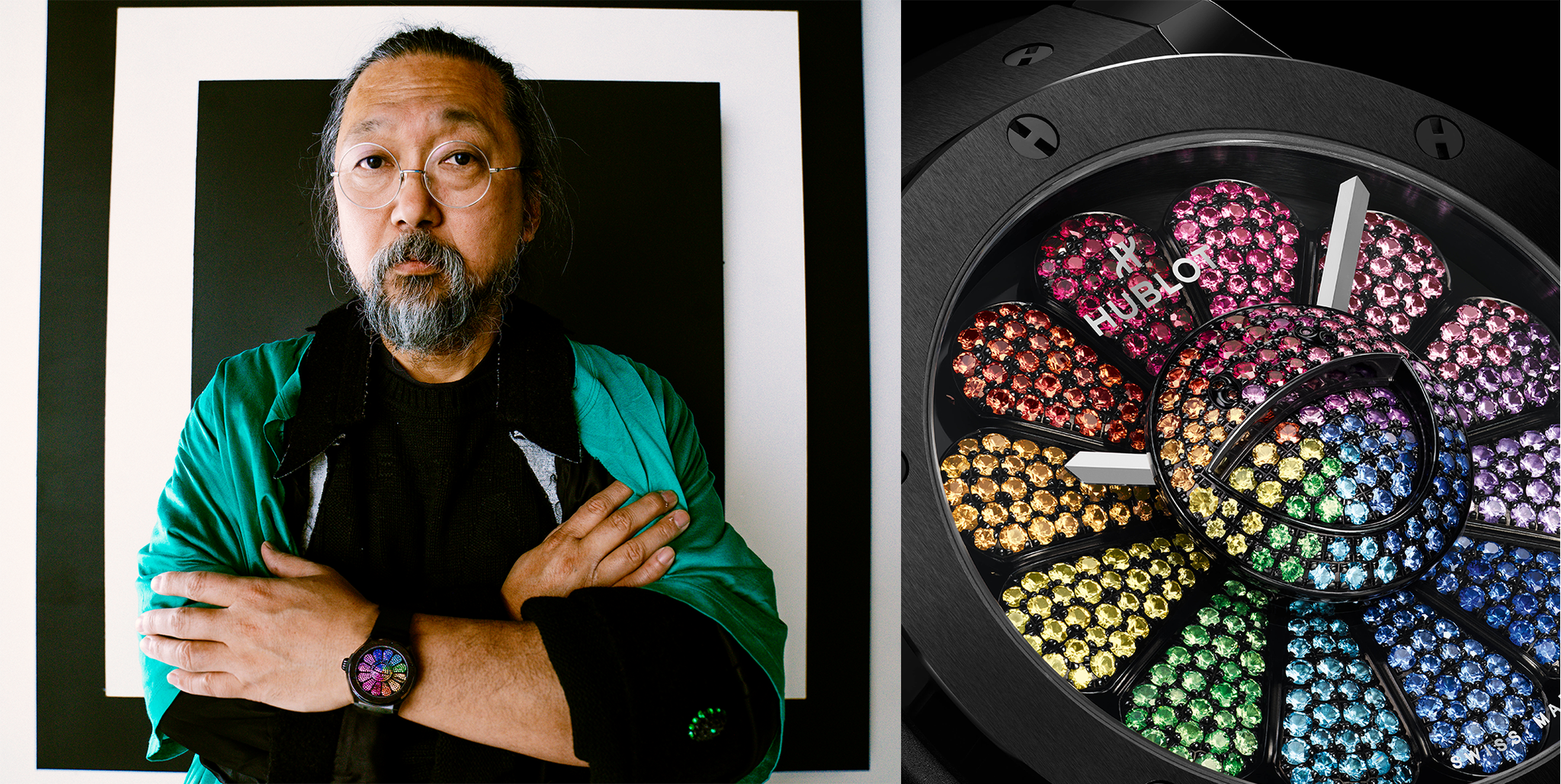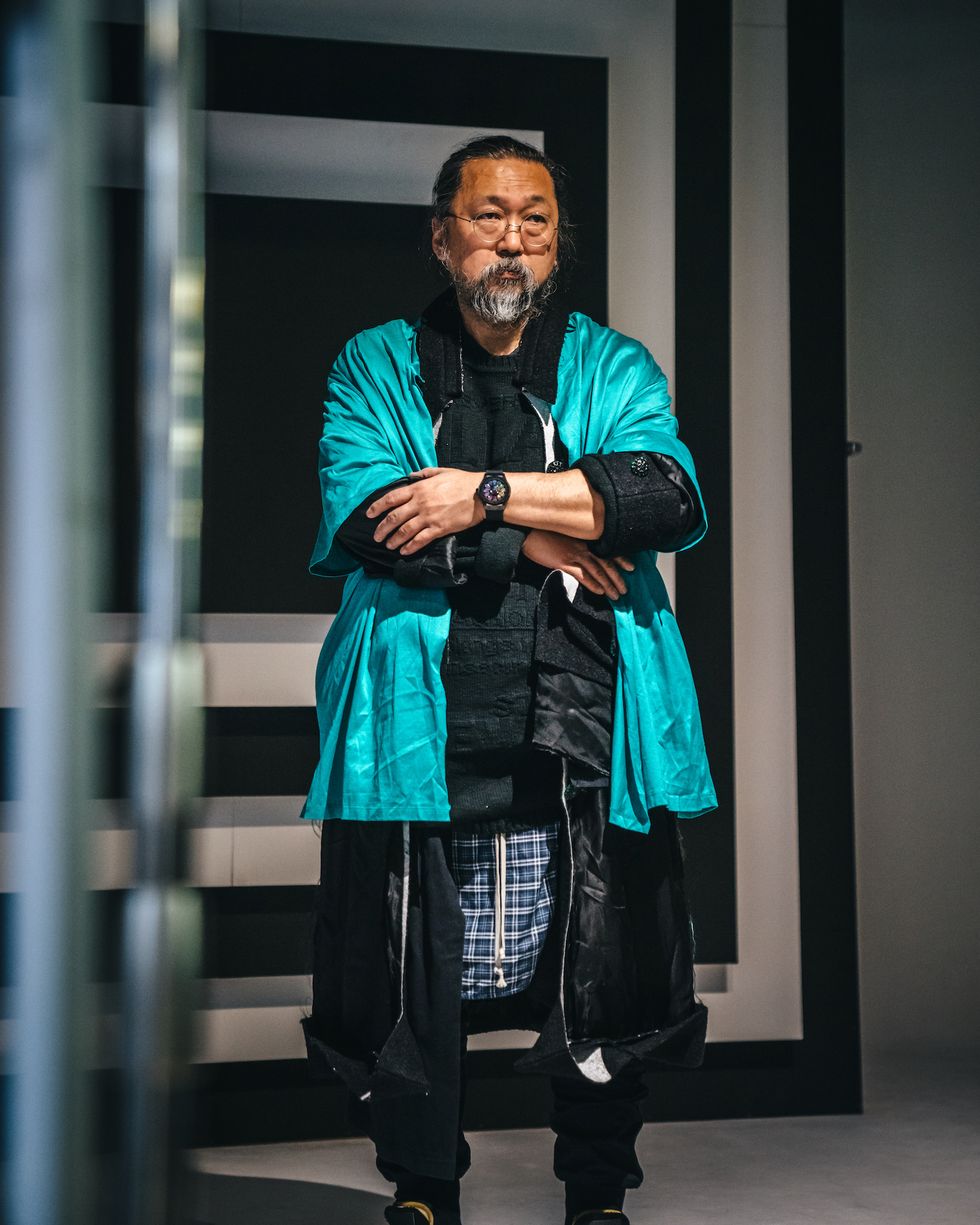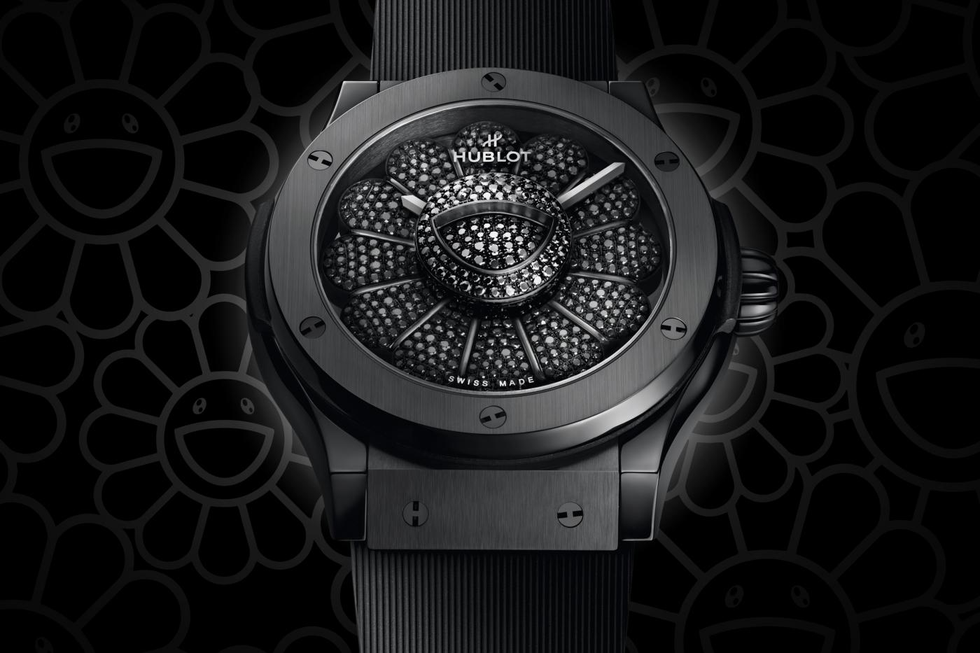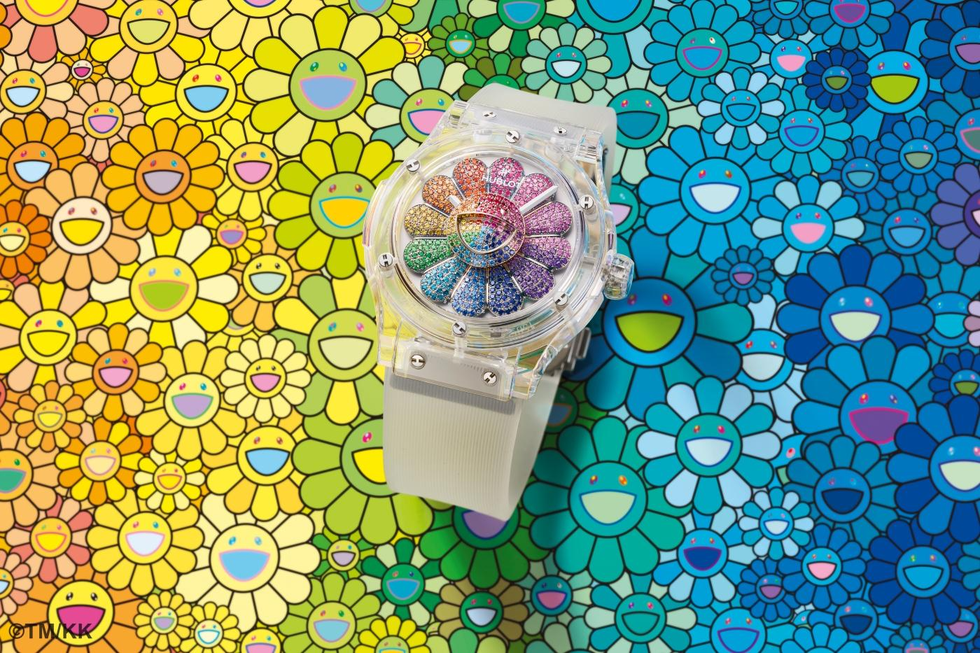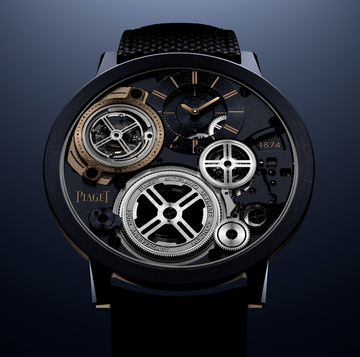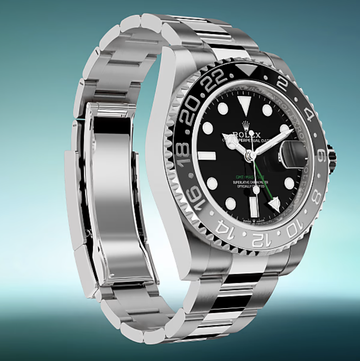On his 61st birthday, Takashi Murakami stands at the bar of an upscale restaurant in midtown Manhattan, New York and poses for selfies. He is dressed in an outsized red checked wool overcoat, a jewel-encrusted gold pendant of his own design and enormous colourful trainers. He is recognisable too by his round wire glasses, ponytail tucked into a bun and pointy goatee. By the ‘smart casual’ dress code of tonight’s dinner invitation it is perhaps a stretch – although it’s also sober by Murakami standards.
On the other hand, as one of the most recognisable and successful artists of modern times – one list places his worth at $100m, above David Hockney and Gerhard Richter but below Jeff Koons and Damien Hirst – he can presumably wear what he likes.
Also, it’s his dinner.
Tonight Murakami is joined by Ricardo Guadalupe, CEO of the luxury watch brand Hublot and 56 guests, largely comprising members of the global media, who have flown in today from Singapore, Malaysia, Switzerland, Italy, France, Germany, the UK, Canada and other parts of the US.
The occasion is a three-day event to launch a new series of watches – the fourth such collaboration since 2021 between the watchmaker, whose slogans include ‘Hublot Loves Art’, and the artist frequently cited as a modern-day Warhol.
After everyone is seated, Guadalupe, who is wearing a navy suit and white shirt and sits in the centre of the room opposite Murakami, stands to say a few words.
“Welcome to this beautiful restaurant for an incredible event that we will have tomorrow together with an unbelievable contemporary artist. Maybe the best in the world. Takashi Murakami – with us tonight.”
The room applauds and whoops. Murakami places his hands together and nods in thanks, beaming.
“We will talk about art, of course. You know that Hublot represents ‘the art of fusion’ in watchmaking. And of course, with Murakami we do the fusion between his art and our art of watchmaking. And we have done incredible product together – two watches already, one all-black [the Classic Fusion Takashi Murakami All Black, in 2021] and one sapphire rainbow [the Classic Fusion Takashi Murakami Sapphire Rainbow, in 2022], inspired by his iconic humanised flower [Murakami’s trademark smiling anime-style design]. We have gone into the digital world as well, by creating some NFTs linked to those watches [the collaboration heralded 324 NFTs, also in 2022] and tomorrow we’re going to do this fusion between digital art and watchmaking. I will finish by saying Takashi-san came over from Japan, and today is his birthday….”
Murakami stands and bows. The room bursts into more applause, almost drowning out Guadalupe’s last words.
“… a lot of health, happiness and success. Enjoy the dinner!”
The next afternoon, around thirty people gather in a room on the ground floor of a hotel on the High Line in the meatpacking district. Here, Murakami will give a 40-minute press conference. All the journalists’ questions have been submitted in advance. This is so they can be compiled and any overlaps can be avoided, explains a Hublot representative. Though it also ensures the questions remain on-brand – at least one attendee had put forward a query about Kanye West, the cover of whose 2007 album Graduation Murakami designed, taking the artist to a new audience, prior to West’s more recent abrupt fall from grace. This does not make the cut. The questions will be read to Murakami by a Hublot representative. Murakami will answer in Japanese. His answers will then be relayed to the room by his translator. The journalists’ job, then, is to listen.
Still, Murakami is a charming and entertaining host.
He also looks incredible. This afternoon’s outfit includes harem pants, a bucket hat a la Brad Pitt in Bullet Train and a blue and white varsity jacket of his own design, incorporating patches stitched onto the sleeves, crucifixion motifs on the back, Jesus artwork on the left chest and the legend ‘Without end or beginning there is no day or night’ embroidered on the right.
You present the fourth collaboration with Hublot today. How did it get started and why did you decide to collaborate with our maison?
“After I did my collaboration with the Louis Vuitton company, the Japanese media mentioned that Takashi looks like ‘some kind of fashion luxury guy’, but I’m not. But I was wondering, after the collaboration: ‘What is art? What is commercial? What is branding?’ Because everything is confused. And the watch brand business is a very good example of that.”
In 2002, Murakami began a 13-year collaboration with Louis Vuitton, at the invitation of its then-menswear designer Marc Jacobs. The deal was prescient. Not only did Murakami go on to become hugely influential, but the idea of a luxury brand giving their IP over to an artist in this way proved significant. Murakami made over Louis Vuitton’s signature monogram collection in 97 pop colours, including hot pink, turquoise and yellow. Holdalls came emblazoned with pink flowers, luggage with eye-popping cartoon characters. For a brand whose origins lie as a trunk-maker to Empress Eugénie de Montijo, wife of Napoleon Bonaparte, the first president of France, it was certainly a different approach to luxury. It worked. The tie-in bought in over $300m for the fashion house. It also kicked-off a new era of fashion-art collabs– Raf Simons x Robert Mapplethorpe, Longchamp x Tracey Emin, Supreme x Richard Prince, the list goes on.
Vogue retrospectively called the Vuitton-Murakami hook-up ‘The Defining Fashion Collaboration of the Noughties’.
Not everyone was convinced it was a good thing. The 2007 exhibition © Murakami at the Museum of Contemporary Art in Los Angeles included a pop-up shop selling $875 Louis Vuitton collab bags, a mix of commerce and art that now seems almost quaint – but proved an affront to some. “[He] has turned the museum into an upscale Macy’s,” grumbled the Vanity Fair art critic Dave Hickey.
Nowadays important dates in the art world calendar like Art Basel Miami Beach are packed with events sponsored by luxury fashion brands, including Hermès, Fendi and Moncler. Prada has opened its Fondazione Prada in Milan, a 19,000 sq m arts complex in which art can be exhibited and shared with the public. And Louis Vuitton now regularly sponsors exhibitions at the Tate Modern and the Pompidou Centre.
“The art world is looking for financial support and a touch of glamour,” Matthew Slotover, co-founder of Frieze and now chair of Turner Contemporary told Esquire in 2013. “The fashion world is looking for cultural credibility and inspiration. Both are looking for new audiences.”
What conditions must a brand meet for a collaboration with you? And is there a special element that you are looking for?
“Four or five years ago, Hublot wanted to make a collaboration. I said ‘I don’t know’. Because I want to make some super-unique stuff. This is one of my conditions. But then I came to the Hublot factory in 2020, and I saw it was incredible quality. Everything is computerisation, plus handmade-style. So that was super-impressive to me. [It made me realise that] my own studio, where I’m creating my painting and sculpture, really needs to keep evolving. So, I have been implementing [some of those ideas] based on my experience of that visit.”
Like Louis Vuitton, Hublot is owned by the luxury conglomerate LVMH. Its first collaboration with Murakami came out in 2021, the Hublot Classic Fusion Takashi Murakami All Black. The face of the watch featured a 3D version of the artist’s signature ‘happy flower’ motif that had been set with 456 black diamonds, with another 107 black diamonds on the watch’s face. The ring of petals was connected to a novel ball-bearing system that allowed them to spin on the central axis, so they rotated as time ticked by.
This was followed in 2022 by an £88,000 sapphire-cased, rainbow-stone-set, limited edition – the Hublot Classic Fusion Takashi Murakami Sapphire Rainbow. This time the face had been set with 384 precious stones, including rubies, pink sapphires, amethysts and tsavorites. In 2022 NFTs were also made available to buyers of both watches, 324 of them in total – this counted as collaboration number three.
In New York, Hublot and Murakami announce plans to further bridge the gap between watchmaking and digital art by releasing 13 new NFTs alongside 13 new watches. Each of the NFTs reference the first All Black watch and are linked to the new watches, which are set to be unveiled at the end of March. Price aside, getting hold of any of the watches won’t be easy. Twelve of them will be available to buy on an ecommerce platform accessible to owners of those 324 previously released NFTs. The thirteenth, revealed in New York as the Classic Fusion Takashi Murakami Black Ceramic Rainbow, can only be obtained if a collector manages to collect all 12 NFTs associated with the other watches in the series. If no one manages to do this, Hublot will auction the watch for charity.
Confusing? Yes, it is.
Do you believe NFTs will have the permanence of art equal to sculpture or painting or something on your wrist?
“With NFT art I myself had that experience of the chemical release. With the whole collecting-and-buying NFTs, the dopamine in my head. So, I said ‘This is something I should do with this collaboration’. This is my second time around [doing NFTs with Hublot]. And I still think we have to do more – and repeat the process. For people to really understand.”
It was Murakami’s mother who had the biggest influence on his interest in the arts. She studied needlepoint and designed textiles; while both parents are said to have asked him to write down reviews of exhibitions he’d seen. (His father was a taxi driver.)
Born and raised in Tokyo, he was a fan of anime and manga from an early age and aspired to work in the animation industry. He studied drafting at the Tokyo University of Arts and went on to focus on nihonga, a broad term meaning ‘Japanese painting’, incorporating traditional Japanese artistic conventions, techniques and materials.
In 1994, Murakami travelled to New York to take part in an international studio programme at the PS1 contemporary art centre, on a fellowship from the Asian Cultural Council. Apparently inspired by Jeff Koons and other American pop artists, he realised a route to success lay in abandoning a more rigorously intellectual approach and to present himself and his art as more ‘quintessentially Japanese’ by riffing on the anime and manga of his youth. He developed a technique that became known as ‘superflat’ – painting that emphasises a lack of any natural perspective, depth or three-dimensionality. In 1993, he created Mr. DOB – his first ‘signature character’, with a maniacally smiling face, razor sharp teeth and huge, roving manga-style eyes. Four years later he made Hiropon – an overly-sexualised female sculpture with a tiny waist, extended pink pigtails and enormous breasts bursting out of a skimpy bikini top, spraying jets of milk around her. The work sold for $427,500 at Christie’s in New York in 2002, and Murakami had arrived as a serious player.
This time you have developed 12 unique NFTs and 12 unique pieces of the Hublot and Takashi Murakami collaboration. Is there a significance to the number 12?
“How many petals does a flower have? Maybe 12. That’s why we chose that. It doesn’t have any deep meaning.”
After Kanye West’s album art for Graduation, Murakami went on to collaborate with Pharrell and Kid Cudi. More recently he directed an animated Billie Eilish in her music video ‘You Should See Me In A Crown’. His designs have been used frequently by both high fashion and high-street fashion. Post-Marc Jacobs at Louis Vuitton, collaborators included Vans, Supreme, Comme des Garçons, Casio G-Shock, New Era, Billionaire Boys Club and Virgil Abloh.
“He has been active across so many channels, different brands, he’s bought all those world’s together,” says Hans Ulrich Obrist, artistic director of London’s Serpentine Galleries, and Murakami’s friend. “He has developed art, music, fashion. He’s found a way to connect with different generations.”
Having done ‘the defining fashion collaboration of the Noughties’, why do fashion brands still find value in collaborating with him, two decades later?
“Because he has kept moving,” says Obrist. “He has introduced new concepts of art like ‘superflat’ and now blockchain. He is someone who unites the humour of [Marcel] Duchamp with the vision of Steve Jobs.”
Hublot is the youngest watch brand in the LVMH stable. Founded in 1980, and it comes without the great 1960s heritage of fellow brands Tag Heuer and Zenith. Instead, it has positioned itself as the more youthful company, plugged into contemporary culture.
“It was one of the first brands to aggressively look at football,” says James Marks, international head of Phillips Perpetual, the specialist watch arm associated with Phillips auctioneers. “If you look at most of the major football teams, especially in the UK, Manchester City, Manchester United, Chelsea, they all still have a connection to Hublot.
“More and more you’re seeing watch brands trying to portray themselves as part of contemporary culture. Look at the rise of Pharrell at Louis Vuitton. Culture is becoming part of marketing for brands. The watch or the clothing represents the culture that you aspire to.”
Does he think a Murakami-Hublot watch will bring in an audience who were unfamiliar with the brand? Art fans?
“Possibly. These days people buy things for reasons other than the one that might seem rational to us – ie: ‘I love it’. We live in a world of social media, where the idea is to make a statement. Other times people buy pieces like that because they want to express their love of art, or the artist. As a Murakami lover you can’t take a piece of Murakami to dinner with you, but you can take the wristwatch. For those that are lovers of Murakami this is the way they can keep something close to their heart, but in this case on their wrist.”
What you used for your Hublot collaboration is your happy, smiling flower. Do you believe, like Renoir, for example, that a work of art should be something pleasant, joyful and pretty?
“Just one of my motifs is the smiling flower. Actually, more than 70 per cent of my work is characters and themes that are on the darker side. I absolutely do not believe that art has to be something bright and happy. It just so happens that my most famous artwork is the happy one. It’s fine for you to enjoy that and think that that is a happy work. But if you only see that part of my work, then you lose the contrast of light and shadow. I think my work has longevity because most of it is actually dark.”
As the term ‘superflat’ suggests, it’s easy to see Murakami’s art as having little depth. But in a 2005 interview with The New York Times, and elsewhere, the artist has explained that his apparent interest in the relentlessly cheerful has its origins in something much darker. He considers Japan’s modern obsession with cuteness and youth to be a response to the western invasion of the country, creating a form of arrested development that bought Godzilla to life and drives otaku [young people obsessed with popular culture] to collect manga and endless pop artefacts. And if fantasy and anime is what the West now thinks Japan has to offer, then Murakami will serve it back to them in the most turbo-charged fashion possible. In particular, his smiling flowers are said to be a manifestation of the repressed emotions and collective trauma experienced by Japanese residents after the 1945 Hiroshima-Nagasaki bombings.
In a 16,500-word essay published on the website of the American writer and researcher Gwern Branwen entitled ‘Earth in My Window’ in 2012, Murakami mused at length on the effect of World War II ‘infantilizing [sic] Japanese culture as revealed by media, anime, and otaku’. Broken up by the author’s own poetry and illustrated with source material throughout, the tour de force takes in Howl’s Moving Castle, Seven Samurai, Akira, Dragon Ball, the daily newspaper Yomiuri, the 1970 World Exposition in Osaka, the manga franchise Crayon Shinchan, the Carpenters’ 1973 album Now & Then, the 2004 movie Crying Out Love from the Center [sic] of the World, based on the hit novel by Kyōichi Katayama, the magazine Quick Japan, the dominance of the American convenience store 7-Eleven, the characters Hello Kitty, Pokémon, Doraemon, TarePanda (or ‘Dropping Panda’), Anpanman (or ‘Bean Paste Bread Man’), the work of 17th Century illustrator Kusumi Morikage, the robot-centric films Ultra Electromagnetic Robot Combattler V(1976), Super Dimension Fortress Macross (1982) and Mobile Police Patlabor (1989), Astro Boy and plenty more besides.
‘Once everything had been blown away in a flash, an infantile and impotent culture gained strength under the rubric of unfounded, puppet national infrastructure,’ Murakami writes. ‘What emerged was a culture frozen in its infancy, earlier than adolescence of even childhood’.
His work has also featured mushroom clouds, references to the Ansei Edo earthquake that killed and injured 9,400 people in Edo [modern-day Tokyo] in 1855, and a life-size replica of a sannon, or sacred gate, from the Heian period, guarded by two huge, grotesque demon sculptures.
In his 2019 Billie Eilish video Murakami’s rainbow flowers lose their smiles, turn dark and get obliterated by an extinction-level city-wide apocalypse.
Elsewhere, his flowers can be seen shedding tears. Murakami is said to have come up with this idea on an early trip to New York, feeling depressed and alienated by the American art market and the gallery system.
He is launching his latest Hublot project in the city, he tells the press conference, because New York is the home of contemporary art. Like the high-low artist he is most often compared to, Andy Warhol, he is aggressively commercial. That is not a criticism – but given his views on the West (or, rather, his view on the West’s view of Japanese art) you might extrapolate that a New York launch comes with extra significance.
Last question: If there is one thing that you hope your work has achieved in the art and the luxury world, what would it be?
“I don’t feel like I’ve accomplished much yet. For example, with NFT art, Beeple had a crazy price at auction [in 2021 the American digital artist sold an NFT for $69m, putting him ‘among the top three most valuable living artists’]. Then I feel ‘What is that?’ And I will go and study and move into that world. So that’s why I don’t feel like I’ve accomplished much yet. I still have to keep trying. So, between now and when I die, maybe another 10 years, If I can manage to create another bridge or two in different cultural realms and you can see my entire career in total until my death, maybe you can start to see what I’ve achieved.”
In a bar in Manhattan’s Chelsea neighbourhood, Takashi Murakami stands at the side of the stage and once again poses for selfies.
Tonight he is wearing a bright yellow hoodie, an outside army-style parka and – on his head – a giant fabric rainbow flower, cut in half and fashioned to form a hat. Displayed on boards around the room are images of his 13 NFTs – pixelated flowers said to be inspired by the rudimentary digital art of 1980s video games.
Before long, Ricardo Guadalupe takes to the microphone to say a few words – and then introduces Murakami.
“Thank you so much everyone,” the artist says, in imperfect English. “This project has for a very long time been a kind of dream. But this is a dream come true. Maybe before there was a very strong collector’s mindset. But now we are pushing for you – what is next? With NFT, maybe the watch collector didn’t understand it yet. What is the watch collection? But soon you will open your eyes! With the NFT stuff you have to say ‘What is the appeal?’ You have to say if you should care! But I was these two years, too much addiction for the NFT collection. That’s why! Thank you so much.”
Then it’s back to the selfies.
Guadalupe surveys the scene from the back of the room – though 12 of the 13 watches still need to be revealed at the end of March, the new collaboration is now officially launched.
“Hublot has been working with artists now for 10 years,” he tells Esquire. “Like the tattoo studio Sang Bleu, Shepard Fairey, [French sculptor] Richard Orlinski. But every time we go one step up. Murakami is the most successful one because he is the most successful contemporary artist. He brings us a new audience because we have Murakami collectors coming to our brand who would never [normally] buy a Hublot watch.”
He thinks about this.
“We cannot compete with traditional watch brands. So, this is a way of being different. There is no one brand that creates a watch like this, you know? That’s why we’re different. That’s why we’re successful.”
